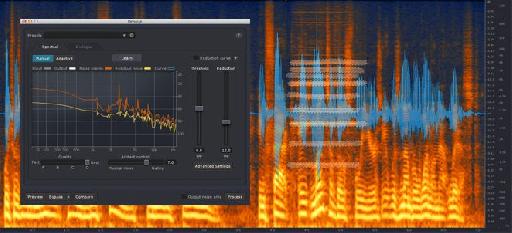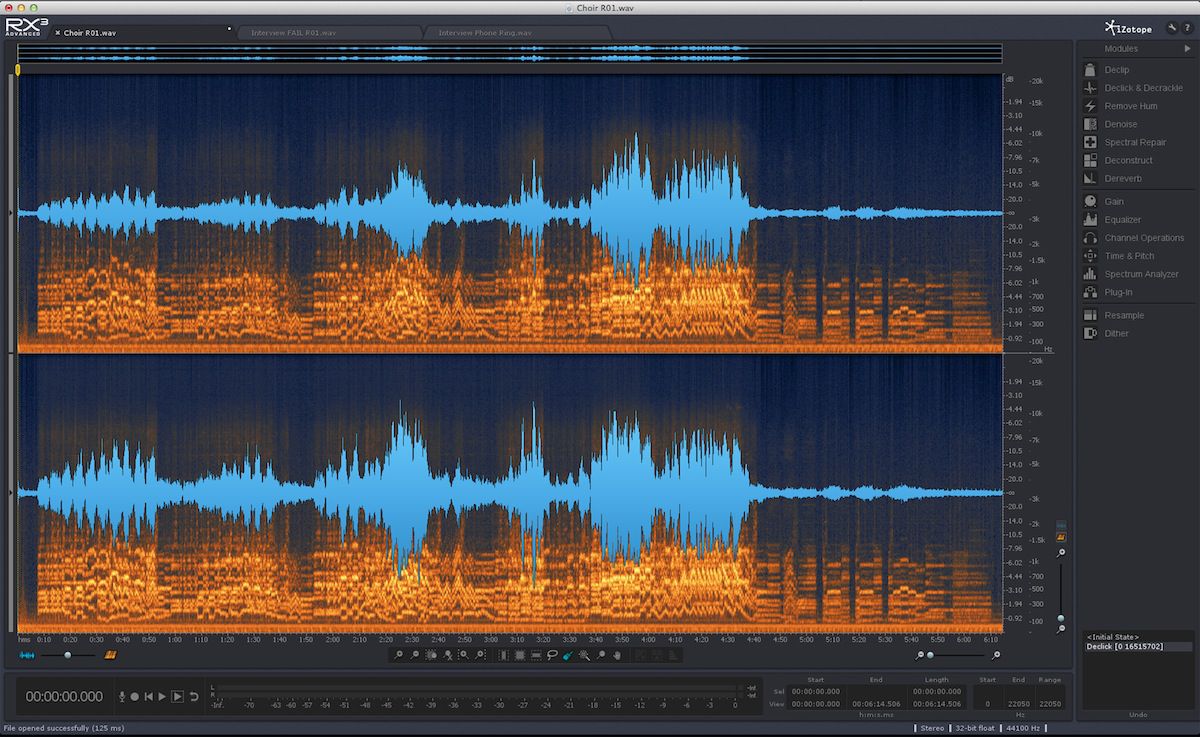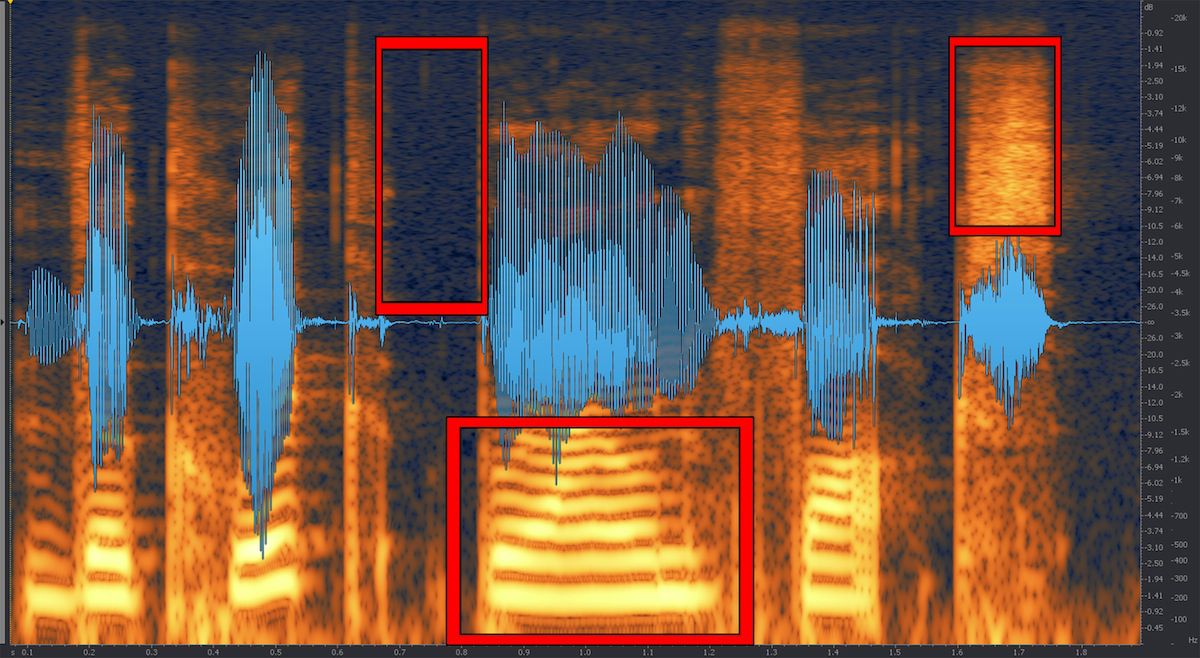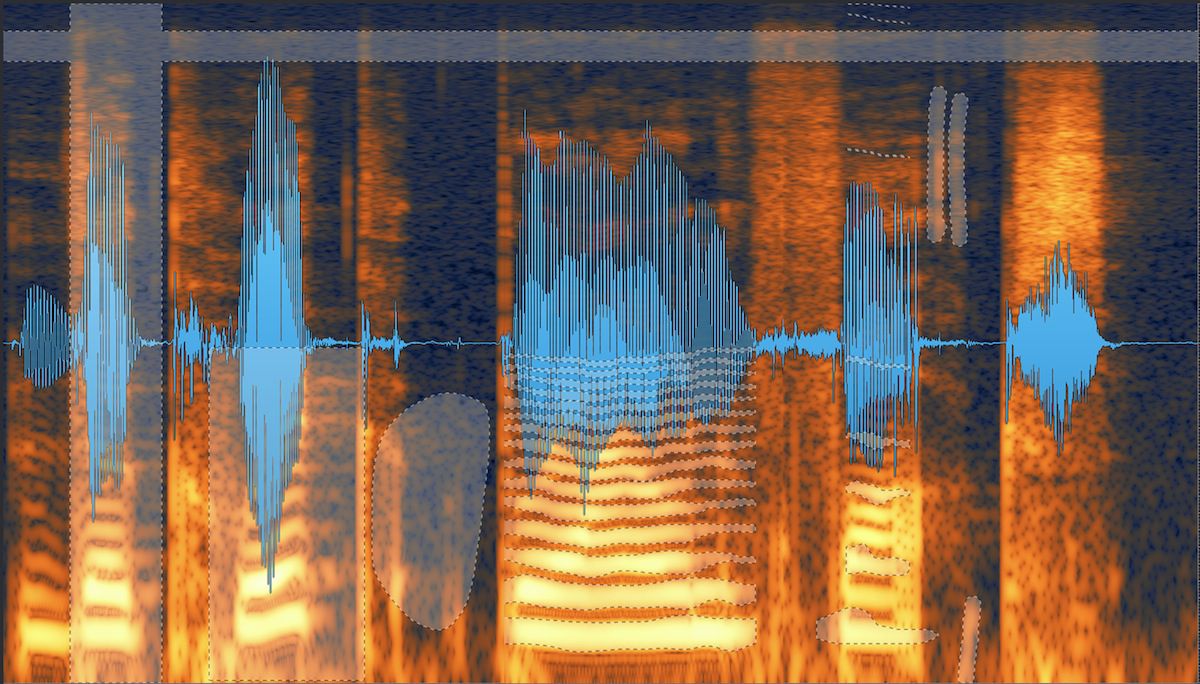For several years, audio producers and forensic audio specialists alike have relied on iZotope RX to improve and even rescue damaged recordings. Now the team in Boston, MA have upgraded the suite to RX3, which has greatly improved a program that, for many, is an indispensable tool. Let's see what RX3 has to offer.
Installation and Application
RX3 is 32- and 64-bit compatible and cross-platform to run on both Mac computers (Snow Leopard and higher) and Windows-based PCs (XP and higher). It is compatible with the iLok, but can also be authorized via serial number without the need for hardware copy protection. It can run in trial mode for 10 days, providing prospective buyers with an unrestricted hands-on experience.
RX3 is a standalone application, or the restoration modules can run as plug-ins in Audio Unit, VST/VST3, RTAS/AudioSuite, and for the first time ever, AAX formats. This provides real-time RX3 processing in virtually any plug-in capable audio program.
Exploring the Interface
RX2, with its brushed aluminum module buttons and pinstripes, looked... well... a little campy. But the RX3 interface is a work of contemporary art, with all of the program elements integrated into one screen.
The RX3 interface.
The largest part of the interface is the waveform/spectrogram display, which has a slider to balance each visual element. The zoom and selection tools are located below the timeline. To the right are the frequency and dB scales, which can both be zoomed to reveal more detail.
Also to the right are the Modules. Clicking a Module will reveal the associated restoration tool. Along the bottom, you'll find the time display, transport controls, VU meters, selection ranges, and the all-important undo list for auditioning 'before' and 'after' versions of your edits. However, RX3 also includes a new RX Document format, which will save the audio file along with all of its associated edits. This makes it possible to load a file and review all the previous edits.
Reading the Waveform and Spectrogram
Most of you will be familiar with the waveform view because it is the standard for audio visualization. However, the spectrogram is a much more powerful way to 'see' your audio. It displays not only the temporal- and volume-based elements, but the frequency-based elements, as well. Things like fundamentals, harmonics, noise, and tonal elements literally jump off the screen and are very easy to see. For example, take a look at the dialog clip in Figure 2.
“The quick brown fox” as shown in the waveform/spectrogram window.
The left-most box in Figure 2 depicts a region that is mostly silent, but the dim spray of orange shows noise or hiss. The center box shows the fundamental and harmonic frequencies of the word “brown”. The right-most box shows the strong 'x' consonant in the word “fox”. Once you get the hang of reading the spectrogram, it's very easy for you to see the kinds of audio elements contained in the waveform.
The Modules and Workflow
The Modules column is split into three regions: restoration, signal processing, and format conversion. Clicking a Module will open its control panel.
The Declip Module (left) and Compare Settings window (right).
Most of the Modules have Preview and Compare buttons, each of which allows for a very useful workflow. Clicking the Preview button will play back the audio while you make changes in the Control Panel, including recalling factory or user presets. After you've made some possible settings, clicking the Compare button will open the Compare Settings window and save a processed version of the audio. Then you can make additional changes and hit Compare again, and repeat the process many times. Then take a look at the Compare Settings window. When you want to audition your edits, click an operation from the list and hit the Preview button. When you find the settings you're happy with, hit the Process button to apply the edit to the audio file, or hit the View settings button to reload them into the control panel for further editing.
Making Selections
Gross edits can be performed on the entire audio file by doing a select-all command. However, more specific edits require a more surgical selection. That's where the selection tools come in.
The selection tools.
Because you'll be selecting more than time-based information, you'll also need to make frequency-based selections, as well. If you've used Adobe Photoshop, you'll already understand most of these tools. There are tools like Lasso, Magic Wand, and Brush, and there's even an Invert Selection button. Plus, you can make selections of up to ten harmonics for easy tonal editing.
Various time- and frequency-based selections.
Restoration Processes
The name of each Module will inform you of its restoration forte. Got clipping? Use the Declip Module. Got hum? Use the Remove Hum Module. Each Module does a masterful job of repairing various audio anomalies. But you should also know that iZotope recommends a two-step philosophy, meaning that you usually get better results by running two gentle passes. In other words, don't run the Declicker with radical settings to get rid of all the clicks in one pass. Instead, run one gentle pass, then try another to eliminate any remaining clicks. I've found this advice to be sound. (Pun intended.)
The New Stuff
RX3 is FAST! In fact, I ran a simple Declick operation on a seven minute audio file. The process took 90 seconds in RX2, yet only 45 seconds in RX3. In fact, whether you're processing audio in one module, or batch processing with many (including your own third-party plug-ins), RX3 harnesses multiple cores on your computer's CPU. Most operations are at least twice as fast as before, and some are as much as six times faster. You can also record directly into RX3, and using the Time selection tool and the Gain Module will allow you to trim segments of audio, as well as adding fade-ins and fade-outs. You can also load multiple audio files simultaneously.
The variety of other new features you get will depend greatly upon which version of RX3 you have. RX3 Advanced comes with the Dereverb Module, as well as the Dialogue mode in the Denoise module. (The former removes both electronic and naturally occurring reverb, whereas the latter makes quick work of cleaning up dialog recordings.) A complete comparison of the differences between RX3 and RX3 Advanced can be found here:
http://www.izotope.com/products/audio/rx/comparison.asp
Conclusions
Because RX3 is such a unique program, finding fault is almost impossible. It truly is the industry standard for audio repair and restoration, and does both easily and quickly. However, there are a few missing pieces. While RX3 does provide some basic audio editing, there's no crossfade editing, nor are there facilities for reversing the audio or adding a volume envelope. While iZotope did not intend for RX3 to be a full-blown audio editor, I do wish it had a few more of the basics.
However, if you need to repair, rescue, or restore any type of audio recording, RX3 is clearly the most powerful tool on the market. It's absolutely one of my 'desert island' apps, in that I'd be lost without it. But don't just take my word for it... Download the trial version from the iZotope website today and see (and hear) for yourself.
- Pros: Unique and powerful audio restoration made easy, fast processing, uses third-party plug-ins, comes with iZotope Insight plug-in (RX3 Advanced only), and great new features.
- Cons: Only minimal basic audio editing, and RX3 Advanced, while offering features not found elsewhere, is still an investment.
- Cost: RX3 $349.00, RX3 Advanced $1,199.00.
Until September 27th, iZotope are offering a discounted price of $249.00 and $749.00 for RX3 and RX3 Advanced respectively! (Another reason to grab it now!)








 © 2024 Ask.Audio
A NonLinear Educating Company
© 2024 Ask.Audio
A NonLinear Educating Company
Discussion
I just learned from your article that the new modules Dialog Denoise and De-reverb are only available in the Advanced version of RX3, which disappoints me a bit. They made so much fuzz about these modules as new features for RX3, and now it's only available in the Advanced package, which is substantially more expensive.
I love RX2 and it saved many a file which was sent in my direction but it seems iZotope has changed their strategy. RX2 Advanced, which is almost 3.5 times more expensive than the normal RX2, was specifically for restoration specialists: Forensic applications, archivists, really special functionality for this user group with logging capabilities. At least that's how they marketed their advanced features back then. By now packing the cool new modules into only that Advanced version, iZotope basically seems to aggressively want to upsell people.
An upgrade to RX 3 Advanced costs about twice as much as people paid for RX2 full version. So what's new for people who just want to upgrade their normal versions? A new UI, statistic windows for RMS and peak levels, the new document format. All nice stuff, but nothing groundbreaking. Recording within RX3? Well, about every software package out there is able to do recording, so this was not really necessary as "feature". RX3 will not be my goto recorder. Their unique selling points are the new modules.
Also, iZotope putting the capability of applying plugins to audio selections into RX3, previously an Advanced only feature, isn't cutting it for me. Otherwise I would have bought Advanced before. I didn't need that feature then, so it's not a selling point for me personally. It seems like an excuse to have more meat in the normal RX3 upgrade. Let's just put a previously Advanced only feature into the normal version so it looks like more stuff.
RX3 is a great program and the UI overhaul is really nice! But paying for an upgrade for some eye candy and stats windows and leaving the REALLY new functions (unless you count UI as a function) to Advanced only, the package that's 3.5 times as expensive as the normal package is a little too aggressive from my point of view.
The price/performance ratio is something with which all capitalists have struggled. For example, a musician who shows up and plays the right notes is certainly marketable. But the one who shows up and adds essence and nuance that no other musician can will most likely (and certainly should) charge more for their services. How much more is be governed by various economic factors, not the least of which are demand and competition.
RX3 is certainly a powerful program, yet it has competitors in its price range. On the other hand, RX3 Advanced has virtually no competitors, and it's extra Modules (like the Dialogue Denoise and Dereverb) take years of research and development to perfect. That's probably the main reasons for a lack of competition: No one else has the requisite expertise and talent to create such unique signal processors. But the future is uncertain, and competitors are always lurking around every corner.
You and I have both pointed out that RX3 Advanced is an investment. But I feel that iZotope have created some truly revolutionary new Modules that are worthy of their price. (Actually, I feel that all software is under priced, but I digress.) Whether my opinion is accurate will be determined by market acceptance. But iZotope is also offering generous upgrade and first-time buyer discounts, and also bundling RX3 Advanced with their $499.00 Insight plug-in for free, thereby increasing the value of the package.
As consumers, we too are constantly weighing the price/performance ratio every time we lay down our hard-earned cash. Speaking only for myself, I'm a 'value hound.' I don't always buy (nor can I always afford) the most expensive item. But I ponder both the price/performance and cost/value ratios prior to every major purchase. That helps me get the most value for the least amount of money, which is the foundation of my investment philosophy.
While I'm quite sure iZotope will read your comment here, I strongly recommend you send it to them directly at support@izotope.com. They are a great company full of great people. They appreciate and respect the views of their customers and will likely respond thoughtfully.
Sincerely,
Matthew Loel T. Hepworth
I agree. The price for RX3 is very modest and the features look to be aimed for most users. For those of us who need even the more "revolutionary" modules I'm prepared to spend extra. As a software developer myself, I know how much time and research can go into creating software. This is mostly not appreciated by consumers as the changes go more than skin deep!
Well done to iZotope for pushing the boundaries.
Want to join the discussion?
Create an account or login to get started!